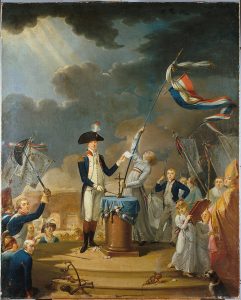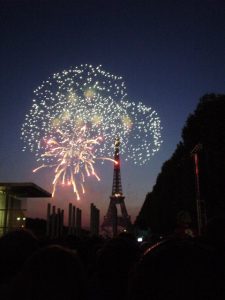“Vive le 14 julliet!” This phrase is associated what English speakers call Bastille Day and the French call “Quatzore Julliet.” It is the anniversary of two early events of the French Revolution: the storming of the Bastille in 1789 and the Festival of the Federation, a mass gathering held in Paris the year after.
The Bastille was originally erected as a military fortress during the Hundred Years’ War. Over time, it was used as an armory and state prison. From the seventeenth century onward, it some French kings imprisoned political dissidents there without trial, which caused the Bastille to acquire a symbolic association with tyranny. However, its use as a prison was dwindling by the eighteenth century: when the Bastille was stormed, there were only seven prisoners within its 100 ft. walls.

Regardless, revolutionary sentiments were simmering by the 1780s. The government spent lavish amounts of money, both on the glamorous lifestyle of the elite and aid to the American Revolution, causing taxes to skyrocket. Crop failures led to famine, with even a loaf of bread costing an exorbitant fee. This all reflected badly on a monarchy that was seen at best as indifferent to the starving masses.
In 1789, there were fears that current ruler Louis XVI was going to arrest members of the National Assembly, the political body representing the interests of the common people. The king concentrated military troops around Paris, strengthening these anxieties. The Bastille’s military-governor Bernard-René Jordan de Launay suspected the prison would be targeted by revolutionaries due to its political associations and supply of gunpowder. His suspicions proved correct: an armed crowd gathered around the Bastille on July 14th.
De Launay had a white flag flown over the fortress and negotiations were attempted, but a battle broke out in the inner courtyard during the conversation, fracturing any possibility of a peaceful outcome. The governor was killed, the prisoners liberated, and the store of gunpowder raided. After the storming, the Bastille itself was demolished by order of the Permanent Committee of Municipal Electors in Paris, bringing its four-century existence to a close.

The July 14th of 1790 was a far less violent event. Thousands of French citizens gathered in Paris to celebrate revolutionary zeal and national unity with military parades, a special mass, speeches, and a feast. Even Louis XVI (now a constitutional monarch rather than an absolute one) and his queen Marie Antoinette participated, making public oaths to honor the upcoming constitution. On that day, many French citizens hoped the worst was behind them, but unfortunately, this July 14th only represented a calm before the storm.
Modern celebrations of “Quatzore Julliet” will likely remind Americans of Independence Day. In Paris, there is a parade down the Champs-Élysées avenue, as well as dancing and fireworks. Celebrations are not exclusive to France either. Some communities in the United States also observe Bastille Day, such as Kaplan, Louisiana, where connections to French culture are enduring.
To learn more about Bastille Day and the French Revolution, check out the resources below.
Learn more about the background of Bastille Day, celebrated every July 14th.



Add a comment to: Bastille Day